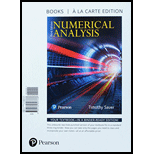
Numerical Analysis, Books A La Carte Edition (3rd Edition)
3rd Edition
ISBN: 9780134697338
Author: Timothy Sauer
Publisher: PEARSON
expand_more
expand_more
format_list_bulleted
Concept explainers
Textbook Question
Chapter 9.1, Problem 3E
Approximate the area under the curve
Expert Solution & Answer
Want to see the full answer?
Check out a sample textbook solution
Students have asked these similar questions
A 20 foot ladder rests on level ground; its head (top) is against a vertical wall. The bottom of the ladder begins by being 12 feet from the wall but begins moving away at the rate of 0.1 feet per second. At what rate is the top of the ladder slipping down the wall? You may use a calculator.
A school counselor is conducting a research study to examine whether there is a relationship between the number of times teenagers report vaping per week and their academic performance, measured by GPA. The counselor collects data from a sample of high school students. Write the null and alternative hypotheses for this study. Clearly state your hypotheses in terms of the correlation between vaping frequency and academic performance.
EditViewInsertFormatToolsTable
12pt
Paragraph
Please help solve the following whilst showing all working out. Is part of exam revision questions but no solution is given
Chapter 9 Solutions
Numerical Analysis, Books A La Carte Edition (3rd Edition)
Ch. 9.1 - Find the period of the linear congruential...Ch. 9.1 - Find the period of the LCG defined by a=4,b=0,m=9...Ch. 9.1 - Approximate the area under the curve y=x2 for 0x1,...Ch. 9.1 - Approximate the area under the curve y=1x for 0x1,...Ch. 9.1 - Prob. 5ECh. 9.1 - Prove that u1=x21+x22 in the Box-Muller Rejection...Ch. 9.1 - Implement the Minimal Standard random number...Ch. 9.1 - Implement randu and find the Monte Carlo...Ch. 9.1 - (a) Using calculus, find the area bounded by the...Ch. 9.1 - Carry out the steps of Computer Problem 3 for the...
Ch. 9.1 - Use n=104 pseudo-random points to estimate the...Ch. 9.1 - Use n=104 pseudo-random points to estimate the...Ch. 9.1 - (a) Use calculus to evaluate the integral 01x2x,...Ch. 9.1 - Prob. 8CPCh. 9.1 - Prob. 9CPCh. 9.1 - Devise a Monte Carlo approximation problem that...Ch. 9.2 - Prob. 1CPCh. 9.2 - Prob. 2CPCh. 9.2 - Prob. 3CPCh. 9.2 - Prob. 4CPCh. 9.2 - Prob. 5CPCh. 9.2 - One of the best-known Monte Carlo problems is the...Ch. 9.2 - Prob. 7CPCh. 9.2 - Prob. 8CPCh. 9.2 - Prob. 9CPCh. 9.3 - Design a Monte Carlo simulation to estimate the...Ch. 9.3 - Calculate the mean escape time for the random...Ch. 9.3 - In a biased random walk, the probability of going...Ch. 9.3 - Prob. 4CPCh. 9.3 - Design a Monte Carlo simulation to estimate the...Ch. 9.3 - Calculate the mean escape time for Brownian motion...Ch. 9.3 - Prob. 7CPCh. 9.4 - Use Itos formula to show that the solutions of the...Ch. 9.4 - Use Itos formula to show that the solutions of the...Ch. 9.4 - Use Itos formula to show that the solutions of the...Ch. 9.4 - Prob. 4ECh. 9.4 - Prob. 5ECh. 9.4 - Prob. 6ECh. 9.4 - Use the Euler-Maruyama Method to find approximate...Ch. 9.4 - Use the Euler-Maruyama Method to find approximate...Ch. 9.4 - Apply the Euler-Maruyama Method with step size...Ch. 9.4 - Prob. 4CPCh. 9.4 - Prob. 5CPCh. 9.4 - Prob. 6CPCh. 9.4 - Use the Milstein Method to find approximate...Ch. 9.4 - Prob. 8CPCh. 9.4 - Prob. 9CPCh. 9.4 - Prob. 10CPCh. 9.4 - Prob. 11CPCh. 9.4 - Prob. 12CPCh. 9.4 - Prob. 1SACh. 9.4 - Prob. 2SACh. 9.4 - Prob. 3SACh. 9.4 - Prob. 4SACh. 9.4 - Compare your approximation in step 4 with the...Ch. 9.4 - Prob. 6SA
Knowledge Booster
Learn more about
Need a deep-dive on the concept behind this application? Look no further. Learn more about this topic, subject and related others by exploring similar questions and additional content below.Similar questions
- Explain the relationship between 12.3.6, (case A of 12.3.6) and 12.3.7arrow_forwardExplain the key points and reasons for the establishment of 12.3.2(integral Test)arrow_forwardUse 12.4.2 to determine whether the infinite series on the right side of equation 12.6.5, 12.6.6 and 12.6.7 converges for every real number x.arrow_forward
- use Corollary 12.6.2 and 12.6.3 to derive 12.6.4,12.6.5, 12.6.6 and 12.6.7arrow_forwardExplain the focus and reasons for establishment of 12.5.1(lim(n->infinite) and sigma of k=0 to n)arrow_forwardExplain the focus and reasons for establishment of 12.5.3 about alternating series. and explain the reason why (sigma k=1 to infinite)(-1)k+1/k = 1/1 - 1/2 + 1/3 - 1/4 + .... converges.arrow_forward
arrow_back_ios
SEE MORE QUESTIONS
arrow_forward_ios
Recommended textbooks for you
 Functions and Change: A Modeling Approach to Coll...AlgebraISBN:9781337111348Author:Bruce Crauder, Benny Evans, Alan NoellPublisher:Cengage Learning
Functions and Change: A Modeling Approach to Coll...AlgebraISBN:9781337111348Author:Bruce Crauder, Benny Evans, Alan NoellPublisher:Cengage Learning Elementary Geometry For College Students, 7eGeometryISBN:9781337614085Author:Alexander, Daniel C.; Koeberlein, Geralyn M.Publisher:Cengage,
Elementary Geometry For College Students, 7eGeometryISBN:9781337614085Author:Alexander, Daniel C.; Koeberlein, Geralyn M.Publisher:Cengage, Mathematics For Machine TechnologyAdvanced MathISBN:9781337798310Author:Peterson, John.Publisher:Cengage Learning,
Mathematics For Machine TechnologyAdvanced MathISBN:9781337798310Author:Peterson, John.Publisher:Cengage Learning,- Algebra & Trigonometry with Analytic GeometryAlgebraISBN:9781133382119Author:SwokowskiPublisher:Cengage

Functions and Change: A Modeling Approach to Coll...
Algebra
ISBN:9781337111348
Author:Bruce Crauder, Benny Evans, Alan Noell
Publisher:Cengage Learning

Elementary Geometry For College Students, 7e
Geometry
ISBN:9781337614085
Author:Alexander, Daniel C.; Koeberlein, Geralyn M.
Publisher:Cengage,

Mathematics For Machine Technology
Advanced Math
ISBN:9781337798310
Author:Peterson, John.
Publisher:Cengage Learning,

Algebra & Trigonometry with Analytic Geometry
Algebra
ISBN:9781133382119
Author:Swokowski
Publisher:Cengage
Numerical Integration Introduction l Trapezoidal Rule Simpson's 1/3 Rule l Simpson's 3/8 l GATE 2021; Author: GATE Lectures by Dishank;https://www.youtube.com/watch?v=zadUB3NwFtQ;License: Standard YouTube License, CC-BY